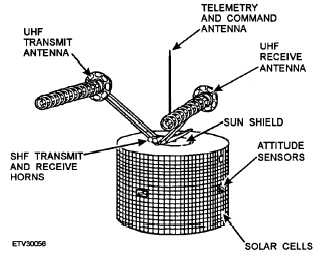six channels function as direct relay channels with
separate repeaters. A LEASAT satellite is shown in
figure 3-18.
Compared to FLSATCOM satellites, LEASAT
satellites have a reduced number of 25-kHz channels.
However, they can still serve expanding Navy
SATCOM requirements by using the groundbased
DAMA technique, effectively using each satellite
channel more efficiently.
UHF FOLLOW-ON SATELLITE
The purpose of the Ultra-High-Frequency Follow-
On Satellite System (UHF F/O) is to provide satellite
communications for DOD and other government
agencies through satellites in geosynchronous orbit.
The current satellites, GAPFILLER, FLTSATCOM,
and LEASAT are approaching the end of their normal
mission life. UHF F/O will provide the needed
replenishment satellites. The strategy for replacement
is to use existing FLTSATCOM and LEASAT assets
fully, while deploying the UHF F/O satellites to
minimize communications disruptions as the
FLTSATCOM and LEASAT satellites fail or reach the
end of their useful life. An exploded view of a UHF
F/O satellite is shown in figure 3-19.
Communications Capability
The uhf communications subsystem consists of
receive and transmit antennas, a low-noise pre-
amplifier, 25- and 5-kHz channel receivers and
Figure 3-18.—LEASAT satellite.
transmitters, and an output multiplexer. The shf
communications subsystem provides shf anti-jam up-
link capability for Fleet Broadcast (which is down-
linked as uhf) and consists of receive and transmit
antennas, the receiver, a dual channel processor, and
the beacon transmitter. Signals received by the shf
receive antenna are fed to the shf receiver. In turn, the
processor provides Fleet Broadcast outputs that are fed
to uhf communications subsystem for down-link. The
multiplexed anti-jam broadcast capability of the UHF
F/O permits up to three broadcast channels to be up-
linked and down-linked simultaneously.
On the fourth and subsequent satellites deployed,
an ehf communications subsystem will provide three
ehf broadcast channel up-links and seven ehf
communications channel up-links. Each of these ehf
up-links will be capable of being down-linked as ehf
only, uhf only, or simultaneously as uhf and ehf. UHF
F/O will also have the capability of transmitting and
receiving ehf telemetry and command data.
User interfaces for UHF F/O are identical to those
of the current FLTSATCOM and LEASAT constella-
tion. The uhf portion of the UHF F/O system is
compatible with all existing Navy uhf terminals except
those using frequency-hopping techniques.
Channel Allocations
The UHF F/O satellite channels are allocated and
grouped as follows:
Group I has a single 25-kHz bandwidth channel
with a variable satellite translation frequency and a jam
resistant shf up-link.
Group II has nine 25-kHz bandwidth channels
with a satellite translation frequency of 41 MHz.
Group III has eight 25-kHz bandwidth channels
with a satellite translation frequency of 33.6 MHz.
Group IV has eight 5-kHz bandwidth channels
with a satellite translation frequency of 73.1 MHz.
Group V has thirteen 5-kHz bandwidth channels
with a satellite translation frequency of 53.6 MHz.
MILSTAR
MILSTAR is a new generation Satellite
Communications (SATCOM) system being developed
by the Navy, Army, and Air Force for two primary
purposes. First, it will provide a survivable
3-22


